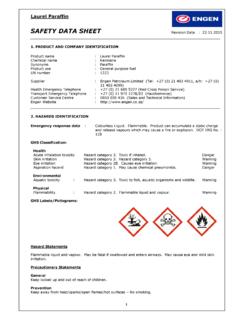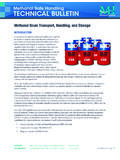Transcription of MS1 METHOD STATEMENT RISK ASSESMENT Servicing, …
1 MS1 METHOD STATEMENT RISK ASSESMENT servicing , repair and installation of Combustion Plant {including general work, systems, boilers and warm air heaters} 1] On arrival to site check in with responsible person, identify self and if required sign in. Make sure that a vehicle can safely be taken on site. Safety Risk Low. Risk to Third parties NIL. 2] Ascertain from responsible person the following information:- Position of appliance to be worked on. What the fire procedures for the site are. Inform responsible person that we will conform to all their safety procedures which we assume to be at least equal to our Safety STATEMENT . If there are any particular safety requirements for site:- b) Site hazards. c) Site chemical hazards including asbestos. Safety Risk Low. Risk to Third parties NIL. 3] At the appliance site assess any immediate hazards before work commences. Are areas of work clear? Any immediate danger from surrounding working environment?
2 Check for service isolation points. (Fuel and electric). Ascertain the position of nearest Fire extinguishers. Ascertain that exits from appliance area are clear. Safety Risk Low. Risk to Third parties NIL. 4] Carry out works as per appropriate appliance service specification or estimate. Procedures to be done in conjunction with Gas Safety ( installation & Use) Act 1998 and subsequent amendments, OFTEC procedures and Codes of good Practice. Safety Risk Medium. Risk to Third parties NIL. 5] Completion of work checks Remove all arisings from site and dispose of safely and correctly. Make sure all service connections are re made and tested as sound. Check settings of all controls relevant to work carried out. Ascertain that the appliance is running correctly. Check back ground CO levels. Fill in paperwork noting all relevant details of work done, work required and appliance state. Safety Risk Low.
3 Risk to Third parties NIL. 6] Report to responsible person and get job sheets signed. If required sign out. Safety Risk Low. Risk to Third parties NIL. For any METHOD , safety or procedural queries contact Mr. Julian Hall on 0114 2903654 MS2 METHOD STATEMENT Gas Connection or Break In To Existing Gas Main Before work commences a function test of all existing gas equipment must be made and any defects reported to the site manager in writing. The gas main is to be visually checked for defects, wrong material, broken or missing brackets and general safety (Use a memo sheet to report faults and get a signature.) No work is to proceed on a gas main that does not conform to current legislation. Any rectification work will be chargeable at normal rates. 1) Test all internal gas mains for soundness. 2) Report any gas leaks for repair during works. (Not included in estimates) 3) Isolate the gas main section to be worked on and disconnect at suitable point blanking off the main side with appropriate plug, spade or cap.
4 3a) Cross bond any sections of pipe that have been removed. 4) If the incoming main is above 1 diameter then it shall be pre-purged with inert gas. If the main is below 1 diameter then it shall be purged with air. Following the procedure laid down in The Institute of Gas Engineers IGE/UP/1 and 1A. 5) Once the main is degassed the connection will be made using standard pipefitting techniques. ( Hot Work METHOD STATEMENT may apply) 6) On completion of the connection the pipe-work will be either coupled up to the new equipment or it shall be plugged off with a suitable device. 7) The new connection will be visually checked and any unions etc. tightened. 8) The section containing the new connection will be soundness tested. 9) The disconnected section will then be connected back to the main and checked. 10) Once all connections are made and secure the section will be purged as in 4) above.
5 All purging to fuel gases will be to outside the premises. 11) A purge is deemed to be complete when all sections of the gas system contain 100% GAS as recorded on a GASCO SEEKER. 12) When the whole of the system is purged a final soundness test will be made and a certificate of soundness for the whole installation will be issued. 13) All existing appliances will be function checked and any new appliances commissioned to manufacturers requirements. 14) All new pipe-work will be labelled GAS every 40 feet and at direction changes. All purging and soundness testing will be carried out in accordance with IGE Utilization Procedures (IGE/UP/1 and 1a) section SOUNDNESS TESTING AND PURGING OF INDUSTRIAL AND COMMERCIAL GAS INSTALLATIONS without exception. This METHOD STATEMENT is meant for customers guidance and is not a task list. SAFETY COMES FIRST WITH NO EXCEPTIONS.
6 For any queries on this METHOD STATEMENT contact Mr Julian Hall 0114 2903654 MS3 METHOD STATEMENT General High Level Works 1) We reserve the right on all jobs to hire, and charge as an extra to the contract, any form of hydraulic access platform that we deem to be necessary for the safety of our operatives and the safety of the site in general. 2) Before high level work commences we will discuss the full implications with the customers site Manager and agree on the correct procedure to adopt. 3) All areas below our high level work area will be cordoned off with RED & WHITE warning tape. This area will be out of bounds for everyone unless permission to enter is obtained from our operatives. Safety shoes and hard hats will be worn at all times in this area. 4) All ladders will be tied off and made safe the bottom of the ladders will be secured or footed by second person.
7 Ladders will not be left upright and unsecured. 5) Ladders will be used at all times following the codes of good practice laid down by the HSE. No faulty or damaged ladder will be used. 6) Where practical an operative working from a ladder will wear a safety harness securely fastened to the building structure. 7) Over reaching on ladders past normal arms length is strictly forbidden. As is the practice of moving the ladder from the top whilst standing on it. 8) Aluminium steps or scaffolding towers will be used in preference over ladders at all times. The use of these items will be governed by the current codes of good practice as laid down by the HSE. 9) All toe boards, outriggers and decking to tower scaffolding will be used at all times. Harnesses will be use where practical fastened to the building structure. 10) The practice of moving a scaffold with someone on it is strictly forbidden.
8 11) No one shall climb up the outside of a tower scaffold. 12) Over reaching on a tower scaffold is strictly forbidden. 13) Ladders and long steps should be carried by two people when possible. 14) Before any ladder, tower scaffold or step ladder is erected any overhead hazard must be made safe. 15) It is forbidden to work on any live electrical appliance whilst standing on a ladder, step ladder or scaffold tower. (Fault finding and commissioning may require the power to a unit to be switched on. In this event all reasonable precaution should be taken to prevent accidents). No electrical connections will be made on live equipment at any time. SAFETY COMES FIRST WITH NO EXCEPTIONS. For any queries on this METHOD STATEMENT contact Mr Julian Hall on 0114 2903654 Established 1974MS4 METHOD STATEMENTHot WorksStep Business CentreWortley Road, DeepcarSheffieldS36 2 UHPhone 08707 447661 Fax 08707 447718 Established 1974 Date.
9 MS5 Scaffold Tower Safety SheetStep Business CentreWortley Road, DeepcarSheffieldS36 2 UHPhone 08707 447661 Fax 08707 447718 The Maintenance and installation of Gas Fired Appliances Pipe-work. Dear Sir, Please find enclosed with this letter the service contract that you requested. If you are putting your service work out to tender please take into account the following points 1) All engineers working on your gas appliances and installation must be properly qualified under the Gas Safety ( installation & use) Act 1998. Each engineer must prove to you by the way of his registration certificate (which he must carry with him at all times) that he is qualified to work on the appliances at your premises. Different appliances may well require a different registration. All engineers must be qualified to work on industrial and commercial equipment. Domestically qualified engineers are not automatically qualified to work on industrial and commercial equipment.
10 Ask every gas engineer that visits your site to see his registration card and check the details on the back. If you have any doubts you can check his registration by phoning 01256 372499 and quoting the card number. The cost of training these engineers is very expensive and the trade knows that some companies are cutting corners and not training their engineers to the correct level. 2) Failure to follow the Gas Safety ( installation & use) Act 1998 can result in severe fines for both gas engineers and their customers. 3) All our services are based on full strip down services as recommended by the manufacturers and as detailed in our service schedules. This type of service should not be confused with the safety checks that some companies offer at a much cheaper rate. 4) Not all service companies offer the same level of service beware of hidden extras once a service contract has been signed.





